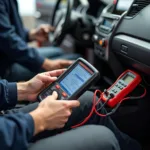Auxiliary lights for trucks are not just a gimmick; they are a crucial factor for road safety, especially during night drives and in poor weather conditions. Imagine driving a 40-ton truck on a dark country road. Your truck’s headlights illuminate the road only a few meters ahead. Suddenly, an obstacle appears at the roadside – a deer, a fallen tree, or perhaps even a broken-down car. You have to react in fractions of a second. In such situations, auxiliary lights can make all the difference.
Why are auxiliary lights so important for trucks?
The standard headlights of trucks are often insufficient to ensure optimal illumination of the road and the surrounding area. This is partly due to the design of trucks, which are often very high and wide, meaning the light beam from the headlights is not always optimally aligned. Added to this are the often long driving hours and the associated changing light conditions that truck drivers are exposed to.
Auxiliary lights, on the other hand, offer a number of advantages:
- Improved Visibility: Auxiliary lights significantly increase the range and width of vision, allowing hazards to be detected earlier and accidents to be avoided.
- Better Illumination of the Roadside: Especially in curves and during overtaking maneuvers, good illumination of the roadside is essential for early detection of potential hazards.
- Increased Safety for Other Road Users: Auxiliary lights make the truck more visible to other road users, which is particularly important at dusk, fog, or heavy rain.

What types of auxiliary lights are there?
There are different types of auxiliary lights for trucks, which vary in their design, performance, and application.
High Beam Auxiliary Lights
These lights produce a strong, focused beam of light that increases visibility over long distances. They are particularly suitable for driving on unlit country roads and highways.
Fog Auxiliary Lights
Fog lights produce a wide, flat beam of light that better illuminates the road even in fog, rain, or snow. They are designed to keep the light below the fog layer, thus improving visibility.
Work Lights
Work lights are particularly robust and resistant to shocks and vibrations. They are used to illuminate the working area around the truck, for example during loading and unloading or during repair work.
What should you consider when buying auxiliary lights?
The selection of the right auxiliary lights depends on the individual needs and the application of the truck.
- Light Color: The light color of auxiliary lights is specified in Kelvin. A warmer light color (e.g., 3000K) is well suited for driving in fog and snow, while a cooler light color (e.g., 6000K) provides better visibility in clear weather conditions.
- Bulb Type: Modern LED auxiliary lights are energy-efficient, durable, and offer high luminous efficacy.
- Approval: Make sure that the auxiliary lights have valid ECE approval so that they can be legally used on public roads.
- Installation: The installation of auxiliary lights should be carried out professionally to ensure optimal alignment of the light beam.

Auxiliary lights for trucks: A must for more safety
“Auxiliary lights are not a luxury, but an investment in safety,” says Dr. Ing. Markus Berger, an expert in vehicle lighting at the Technical University of Munich. “Especially for trucks, which are often on the road under difficult conditions, auxiliary lights can help to prevent accidents and save lives.”
Questions and Answers about Auxiliary Lights for Trucks
Can I install auxiliary lights on my truck myself?
In principle, it is possible to install auxiliary lights yourself. However, you should have a certain level of technical understanding and follow the manufacturer’s installation instructions exactly. To ensure that the lights are correctly aligned and comply with legal requirements, it is recommended to have the installation carried out by a specialist workshop.
How many auxiliary lights am I allowed to install on my truck?
The number of auxiliary lights allowed is regulated by law and varies depending on the vehicle type and registration. Therefore, inform yourself in advance about the applicable regulations in your country.
Where can I find more information about light bars for trucks?
Further information on this topic can be found in our article about MAN TGS light bars.
Conclusion: Invest in your safety and the safety of others
Auxiliary lights for trucks are an important part of the safety equipment and contribute significantly to improved visibility and increased safety on the road. When choosing the right lights, you should pay attention to quality, performance, and valid approval.
Contact us today, our team of auto experts is always available to help you with advice and assistance to find the optimal solution for your needs!

